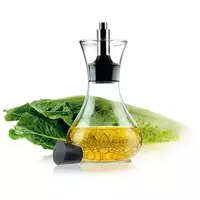Salad dressing

The colourful history of salad dressings or sauces traces its origins to the Age of Antiquity. In ancient Rome and Greece, the first salad dressings began to be made on the basis of vinegar, as well as spices and spices. More than five thousand years ago, China actively used salad dressings based on soy sauce, as well as rice vinegar. Often salad dressings are called dressings or sauces.
Salad dressing is believed to tie together all the ingredients of the dish and help achieve the integrity of the taste, as well as the aroma of the finished culinary product. In addition, salad dressings are used to give dishes additional taste, and in addition, aromatic characteristics. For example, a regular vegetable salad can become savoury if you season the dish with a spicy dressing.
For residents of our latitudes, vegetable oil, vinegar, as well as sour cream and mayonnaise can be considered traditional salad dressings. For each variety of salads in cooking, there are several alternative salad dressings. Especially popular is the French salad dressing for vinaigrette. In addition, in the European culinary tradition, salad dressings are used based on fermented milk products, usually natural yogurt or homemade mayonnaise.
It is worth noting that salad dressings can be used not only for the manufacture of salads. Some types of salad dressings can be used as dip sauce, which is served to dip various snacks. There are recipes for buttermilk-based salad dressings, as well as cream or crème freshei. Salad dressings include mustard, lemon juice, as well as finely chopped greens, wine and tomato paste.
There are countless recipes for salad dressings. It is worth noting that the composition of the initial ingredients for salad dressing depends only on the imagination and taste preferences of the cook. Professional culinary experts divide all types of salad dressings into two large groups. The first group of salad dressings include sauces that are made based on vinegar, vegetable oil, as well as spices and spices.
It is better to combine such salad dressings with salads made of fresh vegetables. The second group of salad dressings is represented by sauces based on mayonnaise, buttermilk, yogurt, as well as sour cream and cream. It is better to use thick salad dressings for salads, which include poultry or pet meat, as well as fish and boiled vegetables.
salad dressing 119 kCal
Energy value of salad dressing (Ratio of proteins, fats, carbohydrates - ju):
Proteins: 2.2 g (~ 9 kCal)
Fats: 10g (~ 90kCal)
Carbohydrates: 4g (~ 16kCal)
Energy ratio (b | y): 7% | 76% | 13%
 Español
Español Français
Français Português
Português Русский
Русский 简体中文
简体中文 繁體中文
繁體中文 日本語
日本語 한국어
한국어 العربية
العربية Türkçe
Türkçe Қазақ
Қазақ Deutsch
Deutsch Italiano
Italiano Українська
Українська
